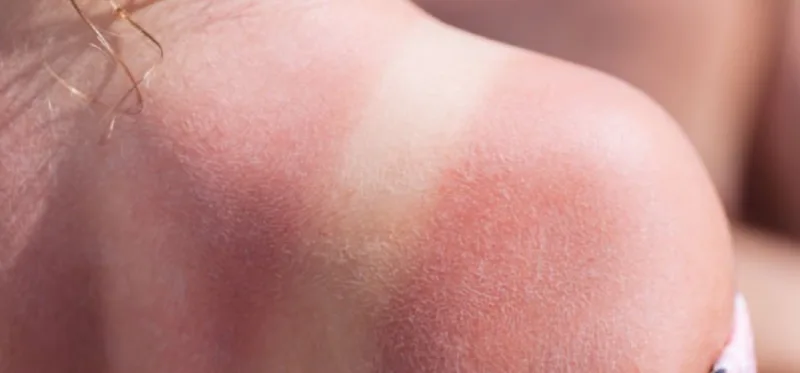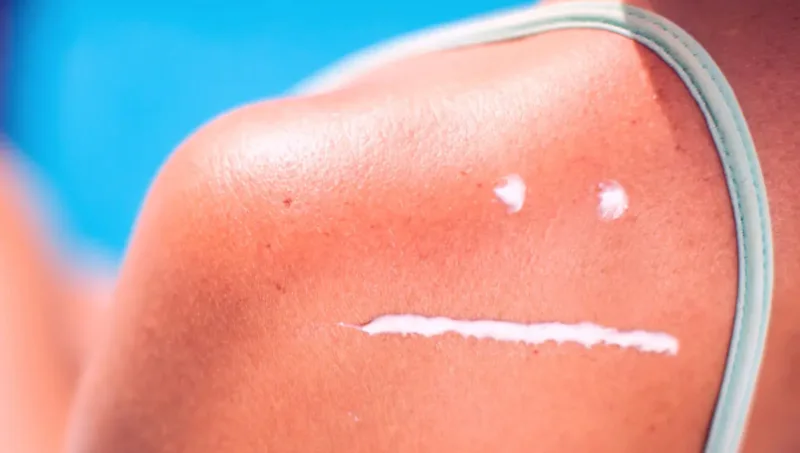On cloudy days, UV rays can penetrate and cause sunburn, leading to painful skin damage. If you can’t see the sun through the clouds, it might tempt you to skip sun protection. Despite being invisible, UV radiation from the sun is potent. Radiation from the sun can still cause sunburn on cloudy days, increasing your risk of skin cancer.
Yes, it is possible to get sunburned on a cloudy day if you are engaged in outdoor activities like cycling but are not adequately protected from ultraviolet radiation (UV). Up to 90% of UV rays can penetrate clouds, causing sunburn.
In this blog post, we will explain 6 reasons you can get sunburned when cycling on a cloudy day, the 6 risks of cyclists getting sunburned on cloudy days, and protection tips.
Can You Get Sunburn On A Cloudy Day For Cycling: 6 Reasons

Cycling is an exhilarating activity that offers a fantastic way to enjoy the outdoors, maintain fitness, and explore scenic routes. However, even on cloudy days, the risk of sunburn is ever-present. Many cyclists underestimate this risk, believing that cloud cover provides sufficient protection from the sun’s harmful rays. Cycling on a cloudy day can get you sunburned for these reasons:
UV Rays Penetrate Clouds
One of the main reasons clouds can burn you is that UV rays penetrate them. Studies have shown that light clouds allow 90% of UV rays to pass through. This means the sun’s harmful rays can still reach your skin even if it isn’t visible. UV radiation can be split into UVA and UVB, contributing to skin damage and sunburn.
UVA and UVB Rays
There are UVA and UVB rays that can penetrate clouds, and they play different roles in skin damage:
- UVA Rays: UVA rays are longer in wavelength and are able to penetrate deeper into the skin. They handle premature aging and can even reach below the water’s surface. UVA rays are present year-round and are not significantly filtered by clouds.
- UVB Rays: These shorter wavelengths are primarily responsible for sunburn. They can damage your skin year-round, regardless of cloud cover. While clouds filter some UVB rays, a significant amount still gets through, posing a risk to your skin.
Reflective Surfaces
When cycling, you’re often surrounded by surfaces that can reflect UV rays, increasing your overall exposure. Reflective surfaces include:
- Water: If your cycling route takes you near bodies of water, the UV rays can bounce off the water and hit your skin, intensifying exposure.
- Sand: Similar to water, sand can reflect UV rays. This is relevant if you’re cycling near beaches or sandy areas.
- Roads: Even roads and pavements can reflect UV rays. Asphalt and concrete can bounce the rays back onto your skin, adding to the cumulative effect.
False Sense of Security
One of the most common reasons people get sunburned on cloudy days is a false sense of security. Cloudy weather often feels cooler, leading to the assumption that the sun’s rays are not strong enough to cause harm. This false belief can cause neglecting sun protection measures, such as sunscreen or protective clothing.
Lack of Immediate Awareness
Sunburn doesn’t happen instantly; it typically takes a few hours for the redness and discomfort to become apparent. Due to this delayed reaction, you may not realize that you’re getting sunburned while outside.
By the time you notice the sunburn, the damage has already been done, making it crucial to take preventive measures even if you don’t feel an immediate burning sensation.
Common Misconceptions
Several misconceptions contribute to sunburn risk on cloudy days:
- Clouds Block UV Rays: Many believe clouds provide a protective barrier against UV rays. While clouds filter some UV radiation, a substantial amount still penetrates through, making it essential to take precautions.
- I’m Safe If I Don’t Feel Hot: The temperature can be deceiving. Cooler temperatures on cloudy days can mask the intensity of UV radiation, leading to inadequate sun protection.
- Sunscreen Is Only for Sunny Days: This misconception is harmful. Sunscreen should be a part of your daily regimen, regardless of the weather, to protect against UV damage.
6 Risk Of Cyclists Getting Sunburned On A Cloudy Day

Cycling on a cloudy day might seem harmless, but the risks associated with sunburn remain significant. Here are some key risks that cyclists face when they neglect sun protection, even when the sky is overcast:
Skin Damage
The risk of sunburn remains because sunlight can penetrate clouds and damage the skin. Even when the sun is not visibly shining, it’s essential to protect your skin using sunscreen and protective clothing. Sunlight still reaches your skin, so taking precautions is crucial to prevent sunburn and potential long-term skin damage.
Increased Risk of Skin Cancer
One of the most severe risks of cycling in the sun is the increased likelihood of developing skin cancer. The UVA and UVB rays cause various types of skin cancer, including melanoma, the most deadly. Even a sunburn can elevate the risk, making it crucial to protect your skin permanently.
Premature Aging
UV exposure speeds up your skin’s aging process, leading to premature wrinkles, fine lines, and age spots. This condition, known as photoaging, can make your skin appear older than it is. Cyclists who frequently ride without adequate sun protection can experience these effects sooner.
Dehydration
Sunburn can impair your skin’s ability to keep moisture, leading to dehydration. Because of physical exertion, cycling puts you at risk of dehydration. Adding sunburn to the mix can exacerbate the problem, making it essential to stay hydrated and protect your skin.
Sun Poisoning
Sunburn on a cloudy day may cause sun poisoning, including nausea, dizziness, fever, and chills. This can be especially dangerous for cyclists far from immediate medical help. The combination of physical exertion and sun poisoning can be debilitating.
Compromised Immune System
A high level of UV exposure may weaken your immune system, making you more susceptible to infection and illness. This mainly concerns cyclists who push their physical limits and rely on a robust immune system to recover and stay healthy.
On Overcast Days, Who Is At Risk Of Sunburn

Sunburn isn’t reserved for clear days, it can occur even on overcast days. Understanding the factors that increase your risk of sunburn can help you take preventative measures and protect your skin. Several factors contribute to increased sunburn risk, regardless of the weather.
Fair Skin
Fair-skinned people with fair skin are susceptible to sunburn. Fair skin contains less melanin, the pigment responsible for skin color and UV protection. As a result, fair-skinned people are less capable of absorbing and blocking ultraviolet radiation, which makes them more susceptible to skin cancer. They have a reduced ability to absorb and block UV radiation, making them more vulnerable to the harmful effects of the sun. Even in clouds, UV rays can penetrate the clouds and cause damage, mainly if your skin has limited natural protection.
Lighter Eye Colors
The eyes of people with lighter eye colors, such as blue or green eyes, often have less melanin in their irises and skin. This reduced melanin level can contribute to a heightened sensitivity to UV radiation. Although eye color may seem unrelated to sunburn, it indicates lower melanin levels overall, which can translate to a higher risk of skin damage from UV exposure.
Lighter Hair Color
A person with lighter hair colors, such as blonde, red, or light brown, are also at increased risk for sunburn. Like fair skin, lighter hair is often associated with lower levels of melanin. This genetic trait can reduce natural protection against UV radiation, making individuals with lighter hair more prone to sunburn, even when the sun isn’t shining brightly.
High Altitude
Exposure to higher altitudes can significantly increase your risk of sunburn. A thinner atmosphere absorbs and scatters UV rays less at altitude. Consequently, UV rays are more intense and can cause sunburn more quickly. If you live in or visit mountainous areas, taking extra precautions against UV exposure is crucial, even on days that don’t seem mainly sunny.
Medications That Increase Skin Sensitivity
Certain drugs increase your skin’s sensitivity to sunlight, increasing the risk of sunburn. For example, St. John’s wort, a joint herbal supplement, enhances photosensitivity. If you take medications that increase light sensitivity, you must be vigilant about sun protection.
Other drugs that can heighten UV sensitivity include tetracyclines, thiazide diuretics, sulfonamides, and fluoroquinolones. These medicines can increase your skin’s vulnerability to burning and damage from UV rays.
Nonsteroidal Anti-Inflammatory Drugs (NSAIDs)
The use of NSAIDs, such as ibuprofen and aspirin, is widespread to relieve pain and inflammation. However, these drugs can also increase your skin’s sensitivity to sunlight. If you’re taking NSAIDs, it’s essential to be cautious about sun exposure, as these medications can increase the likelihood of sunburns and other forms of sun damage.
Retinoids
Topical retinoids like tretinoin are often prescribed for acne and other skin conditions. While they effectively treat these issues, retinoids increase sensitivity to UV radiation.
It is possible for this increased sensitivity to result in sunburn and other skin damage. If you are using retinoids, it is essential to apply them with a broad-spectrum sunscreen and avoid prolonged sun exposure.
Tropical or Subtropical Climates
Tropical and subtropical climates increase your risk of sunburn due to consistently high UV radiation levels. In these regions, the sun’s rays are often more direct and intense, increasing the likelihood of sunburn even on overcast days. Adopting rigorous sun protection practices to safeguard your skin from UV damage is crucial if you reside in such climates.
7 Best Way To Protect Yourself From The Sun On A Cloudy Day
It is possible for ultraviolet rays to penetrate the skin and cause damage. Adequate sun protection is essential regardless of the weather. Here are several steps to ensure you’re well-protected from UV exposure:
Use Multiple Types of Sun Protection
Each sun protection method is unique, so combining different protection is the best approach. Here’s how you can create a comprehensive sun protection strategy:
Cover Up with Clothing
UV rays can be effectively shielded by wearing protective clothing. Clothing labeled with Ultraviolet Protection Factor (UPF) offers higher UV protection. Long-sleeved shirts, long pants, and dresses can cover more skin and provide better protection. Make sure to wear clothing designed for sun protection, which often features tighter weaves and unique treatments to block UV rays.
Wear Sunglasses
Your eyes are vulnerable to UV damage, just like your skin. Experiencing UV light for an extended period of time can result in severe eye diseases, such as cataracts and macular degeneration. UVA and UVB blocking sunglasses are recommended. This protection will help safeguard your eyes and the sensitive skin around them.
Apply Broad-Spectrum Sunscreen

Protect yourself from the sun with sunscreen. You should use a high-SPF broad-spectrum sunscreen if you burn easily. Protective sunscreens that block UVA and UVB rays are broad-spectrum. Reapply sunscreen every two hours, or more frequently if you’re sweating or swimming. Overcast days do not make sunscreen unnecessary because UV rays penetrate clouds.
Seek Shade
A shaded area can significantly reduce your exposure to UV radiation. This is especially important when the UV index is high, which can be checked on most weather channels, apps, and websites. As much as possible, keep yourself in shaded areas between 10 a.m. and 4 p.m., such as under trees, umbrellas, or other shelters.
Wear a Wide-Brimmed Hat
The wide brim of a hat protects your face, neck, and ears. If you want to block UV rays, choose a hat with a brim at least 3 inches long. Hats made from UV-protective fabrics are also available and provide enhanced sun protection.
Avoid the Sun During Peak Hours
UV radiation is most substantial when the sun is at its highest, typically between 10 a.m. and 4 p.m. To minimize your UV exposure, Try to limit your outdoor activities during these hours. If you need to be outside, follow all the sun protection measures mentioned above.
Conclusion
So when you gear up for a ride on a cloudy day, remember that UV rays are still lurking behind those clouds, ready to catch you by surprise.
Whether it’s the sneaky UV rays penetrating the clouds, the reflective surfaces amplifying your exposure, or simply the deceptive coolness of the weather, taking proper sun protection measures is key. Don’t let a cloudy day trick you into skipping sunscreen or protective clothing.
By following these sun-smart tips, you can enjoy your cycling adventures while keeping your skin safe and sound. Stay vigilant, protect yourself, and ride on without worrying about sunburn spoiling your fun.
FAQs
How Much Sunscreen Should You Apply On A Cloudy Day?
Adults should use about 1 ounce of sunscreen per application, which is roughly the amount that would fit inside a shot glass.
Rub the sunscreen thoroughly into your skin and reapply every 2 hours while in the sun. Apply sunscreen before heading outdoors, as it takes about 15 minutes to be absorbed into your skin.


